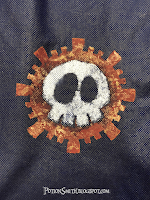Once again playing with different textures.
I still don't have any stencils. I haven't seen any in the stores that really interest me. On the other hand I saw a lot of skeletons that did. They have bunnies, racoons, chameleons...so many new skeleton critters. I'm generally a poor consumer, there is so much marketing out there that is wasted on me. But whoever the evil genius is that decided to branch out the skeleton industry should get a promotion. Every year it gets harder to resist and they're not even anatomically correct. This year I only bought a bunny and a large frog...so far. And I had to buy the frog because the small one I have needed a buddy. So that counts as an act of kindness, not consumerism. At this rate don't be surprise if I set up the weirdest pet shop scene in a few years.
Anyway, I might have to order stencils online, but that opens up a kagillion possibilities and I'm not good with choices and making up my mind. So procuring stencils is going straight on the procrastination list for now.
In the meantime I might not have stencils but I have this shelf liner stuff. It's great for lining the plastic containers that I keep my tools, wire and whatnot in. The design is really too small to stencil well, but it creates some interesting texture. I applied product over the top it like you would with an actual stencil, but pressing it onto a thick medium would also create texture. You could even apply ink or paint on it and use it like a stamp.
You can buy texture paste or you can make your own. All the recipes I've seen are very similar and use 1-2 parts acrylic paint or gesso, 1 part pva glue or mod podge, 3 to 4 parts talc powder or baking soda. I haven't tried any of them yet, I still have some old spackle I've been trying to use up. On a side note Monster Mud is 1 part latex paint to 5 parts drywall joint compound. I think you should just mix up whatever you have on hand and see what happens.
From left to right I used a mixture of 1 part glue, 1 part acrylic paint, 2 parts spackle; the center is 1 part latex primer paint to 1 part spackle; the last is 1 part latex primer to 2-3 parts spackle. All measurements are approximate and all mixtures were applied randomly. A scientific comparison this is not. Those are finishing nails along the center piece.
My other not-stencil is a plastic mesh liner that came with the pizza we ordered a few weeks ago. Again I used it as a stencil, but it could be used other ways too. From left to right they show the same mixtures I used above.
The middle piece with the 1:1 primer and spackle mixture was too thin. You can't tell by looking at it now but the pattern was uniformly stenciled over most of it. It kind of oozed together. The really fine grid texture towards the bottom is from a piece of cheesecloth that I accidentally laid on it and removed before it was finished drying. One of those interesting mistakes to keep in mind for future use.
The last one with the thicker mixture was a little too perfect, so I used a broken tongue depressor to create some interest. I like how the jagged edge creates lines of varying depth. Come to think of it, glued on jagged pieces of broken tongue depressor would be cool too.
One more thing on my list of things to try has been ink sprays. The same day I picked up that embossing folder there were inks on clearance from the Dylusions line of Ranger inks. They were all two packs containing Fresh Lime and London Blue. I've heard good things about Ranger inks, why are these two colors so sketchy they were sent to the clearance aisle?
Never having played with inks, I've been spraying them on everything to see what happens. In this case not much. The tag above on the left and the one below on the far right I painted with my daughter's old watercolor set. The others were sprayed with the inks and while they looked amazing wet, once dried the color was barely noticeable. I didn't really expect them to perform well on such a dark surface, but if your looking for a subtle color variation it'll do the trick.
I played around with watered down acrylics over the ink ones. I have to say I like the watercolors better or maybe I just didn't add enough water to the acrylics. I guess I will just have to play more.










































